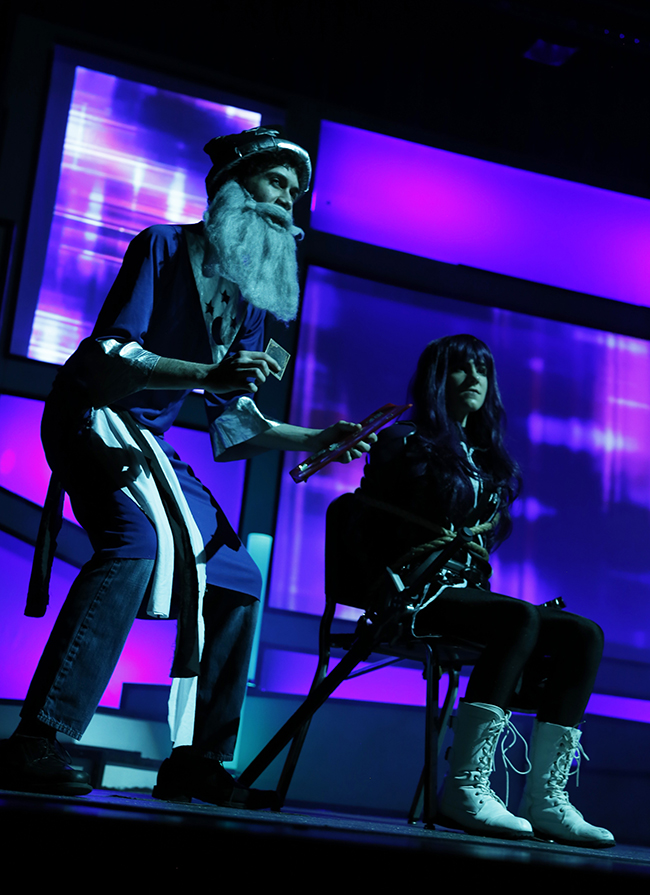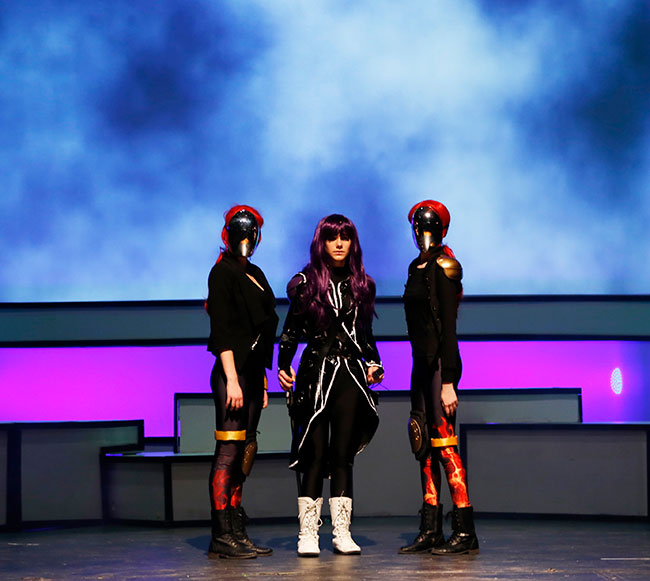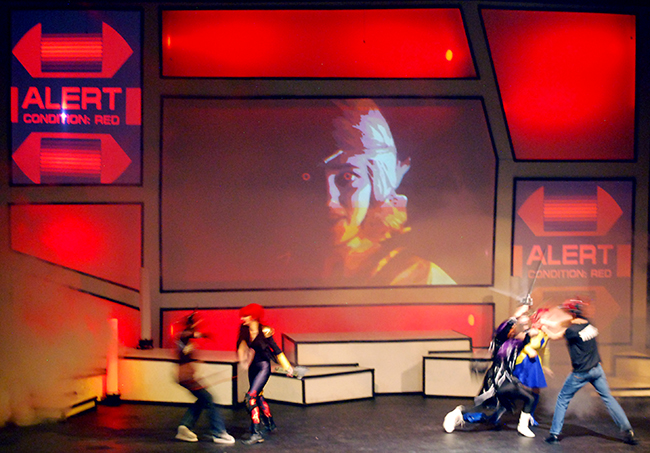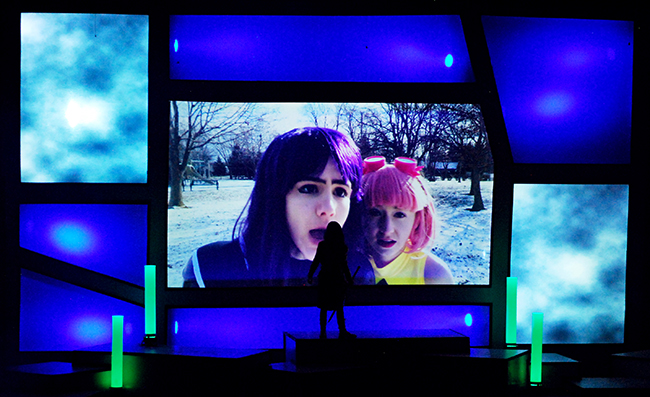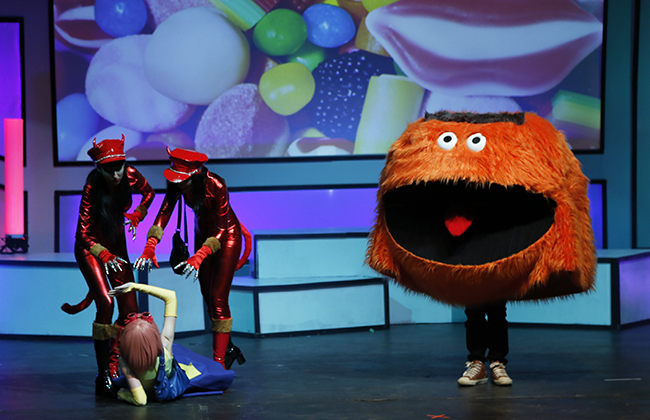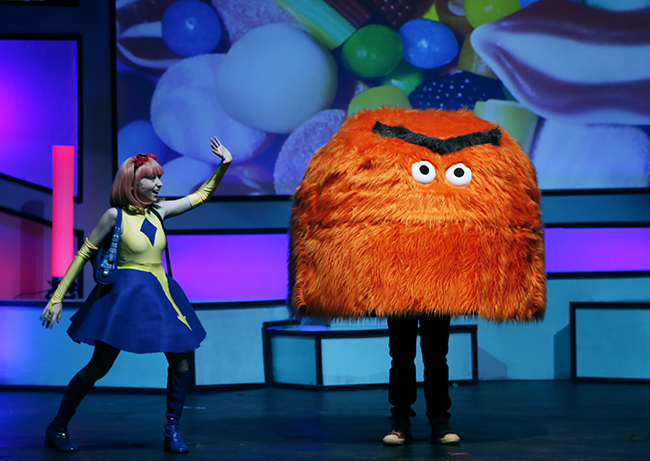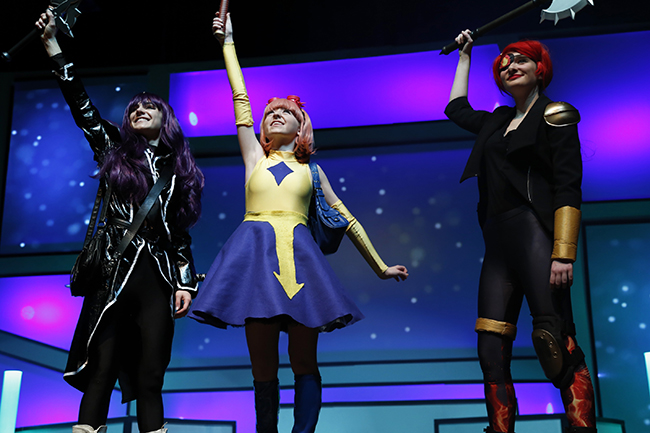
To all high school theatre directors, I have just three words: “Do Geek! now!” Not “someday.” Not “after I find that perfect student.” Not “after I do these other five shows on my bucket list.” Now. This very next season. You will thank me. After doing this job for the last 20 years I can say with certainty that from a teaching perspective, shows like Geek! are rare. They don’t just fall into your lap every day. When you find them, you have a duty to bring them to life.
So, what’s so great about it?
It fulfills multiple educational objectives because it:
-
provides a story demanding rich and powerful characterization from your performers
-
offers a wide array of unusual technical challenges for your crew
-
provides a practical opportunity for students with a different set of skills to apply their talents to a large collaborative project (film making and puppetry)
While simultaneously:
-
tackling a contentious social concern for your target teenage audience (cyber bullying and suicide)
-
featuring characters that not only appeal to the obvious niche audience of anime super fans, but to anyone who’s ever felt marginalized or misunderstood — in other words, everybody
For the purposes of this article, let’s focus on two of those special attributes — the show’s technical challenges and its audience appeal.
The first rule of marketing is to know your audience. Professional theatres know this adage all too well. If you don’t appeal to your specific audience well enough, you won’t continue to operate for very long. If you are directing plays in a high school, your target audience isn’t that group of lovely and supportive folks from the senior center across town (although we certainly do appreciate them). It’s the student body of your school — those teenagers that may never have had an experience inside of a theater before, or the ones that might spend their entire lives without ever going to see a live production outside of a theme park. That is, unless you do something to reach out and show them that theatre can and should be a relevant and meaningful experience for everyone.
Whether we like it or not, you and I are in the business of creating the next generation of theatre goers and as such, we have a responsibility to connect with our students in a real and meaningful manner. Theatre is a model of communication — it requires a giver and a receiver — and if we lose our receiver, we cease to be.
The trick in educational theatre is to figure out how to use what kids already know and love to push them into growth bit by bit, careful not go too quickly or scare them away.
Case in point: I once brought a group of students to the Tate Modern in London and was shocked at the fun some of them had mocking works from one of the finest art collections in the world — until I realized that many of them had never even stepped inside an art museum before. It was simply too much, too soon for them to appreciate it.
The more you can scaffold your audience’s theatre experiences, the more they will go along for the ride. If you can ensure that experience is a positive and meaningful one, you may have just planted the seed that will one day become tomorrow’s thriving audience.
When it comes to connecting meaningfully with a high school audience, I don’t know of a show I’ve produced in my entire career that was more successful than Geek!
This is not to say, however, that it doesn’t come without a very unique set of challenges — challenges that may very well lie outside the scope of a traditional theatre program’s regular day-to-day playbook.
First, the subject matter — Anime cosplaying adventurers whose journey to meet the creator of their favorite manga forces them to examine their personal demons; the story also happens to mirror the structure of Dante’s Inferno in very interesting ways. Oh, and they fight. A lot. It’s undeniably a cool premise, but if you live outside of the cosplaying world’s bubble, this could sound pretty intimidating. Let me be the first to admit that prior to taking on this play, I knew almost less than nothing about the world of anime. My previous experience with the entire genre consisted solely of falling asleep while watching Akira on VHS at 3:00 am in high school. Not the greatest of qualifications.
My complete lack of experience with this world did not hold us back, however. If anything, it gave me a greater window into the universality of the play’s themes — the exact thing that made it feel relevant to our audience.
What about the technical requirements, you ask? To be honest, when taken at face value they can be exceptionally challenging and I am incredibly fortunate to work in a school with the means to bring them to life as written. But that is not to say that there are not wonderfully engaging ways to creatively handle the show’s unique needs. Here’s a sampling of how we approached some of them…
Projections: Our production used a great deal of projections. On the plus side, that meant that we were able to build the permanent scenic elements quickly (for us, a large wall with screened panels made to look like a manga page), leaving the bulk of the visual work to a handful of individuals working on their own schedules. The cosplay video segments were shot by one of the film students in our school’s media production program and I remained (mostly) hands off. The videos are supposed to look like they were filmed by high school students, after all. We then projected public domain images or video for the majority of the locations, and purchased a few of the more important clips from Pond5.
While it is perfectly acceptable to play the video moments live on stage, I highly recommend filming the cosplay clips if possible because this greatly enhances their potential for impacting your audience. For example, the scene in which Danya stands powerless as the final clip plays and she is forced to watch the source of her pain play out in front of her is dramatically intense, especially for a character who’s primary arc involves learning to accept (rather than fight against) life’s struggles.
Puppetry: The character of Squeaker is a full body puppet, originally designed to look like a giant orange Pac-Man. While there are most certainly better ways to build him, (he was only the third puppet I have attempted to build) ours consisted of a skeleton made from rigid foam insulation, covered in a layer of soft upholstery foam for structure and then covered again in fur. The moving frowning eyebrow was simply hinged in the center with tape and was pulled by the actor with fishing line. Yes, he was a challenge, but if I can build him with next to no puppet making experience, you can too. And if you happen to have that student dreaming of “someday” at the Henson Creature Shop — you’ve hit the jackpot!
Fighting: There are fight sequences at almost every junction at which our heroes move from level to level at the convention (descend from circle to circle in Hell). As a director, I have never worked with an outside fight choreographer before, but a quick internet search and a few emails to colleagues landed a talented and licensed instructor. If you are not a qualified fight coach, I cannot stress enough the importance of hiring a professional to teach your students to fight safely and consistently. Plus, this frees you up a bit to tackle the show’s incredibly fun costuming demands.
Costuming: Costuming is important no matter the show choice, but how often do you actually get to create your very own animated world? Yes, it took a little more effort than normal to pull off, but boy was it fun. Not just steampunk, but a hip-hop steampunk army! Not just a Minotaur, but a Minotaur played by a fifth grade girl! A battle-bot with dental headgear! Dancing dwarves and elves! Does costuming get more enjoyable than this?
I could continue to go on, but the ultimate takeaway is that there are always creative solutions available when one is willing to go on the quest to find them. Yes, on paper it can look like an impossible challenge, but with all that Geek! has to offer you, your performers, your technicians, and your audience — this is a challenge that you need to accept.
To purchase a copy of Geek! click here, and to learn more about licensing a production, click here.

Noël Coward’s Travels

Kate Chopin in New Orleans: Mother-Daughter Author Duo Collaborate on Historical Book


